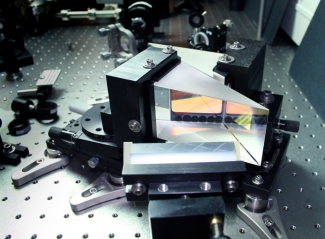Fellows Ralph Jimenez and Henry Kapteyn and their groups recently helped develop optical technology that will make femtosecond laser experiments much simpler to perform, opening the door to using such lasers in many more laboratories.
The technology, which employs reflection grisms as laser pulse compressors, has been patented and is now available commercially. A reflection grism consists of metal reflection grating mounted on one face of a prism. Properly designed, they can compensate for dispersion (with efficiencies of up to 90%) from hundreds of meters of glass (fiber) path and withstand high average powers. They are also easy to align.
Reflection grisms are a major improvement over traditional transmission grisms whose low efficiency made them less than ideal for dispersion compensation and pulse compression. With high-efficiency reflection grisms, it’s a whole new ballgame. With them, laser light first diffracts from the grating and then propagates through the prism. It then refracts out of the prism at an air-glass interface tilted at a large angle with respect to the grating. Precise design of this exit angle is responsible for the high diffraction efficiency of the new grisms.
High efficiency is a key reason why grisms make good pulse compressors. It means they can be sized and aligned to precisely oppose the pulse stretching and asymmetric distortions that naturally occur when a laser pulse travels through a dispersive material such as glass.
Inserted into a laser’s optical path, pulse compressors employing reflection grisms ensure that a laser pulse reaching its destination looks just like the high-quality pulse leaving the laser — fully compressed, with high-peak power. Research Associate Emily Gibson, Graduate Student David Gaudiosi, Fellow Margaret Murnane, and colleagues from the Colorado School of Mines, Cornell University, and Horiba Jobin Yvon, Inc. worked with Jimenez and Kapteyn to develop the new high-efficiency pulse compressors.
The new technology was applied to downchirped-pulse amplification, a relatively new technique for producing very high-average-power amplified laser pulses. The original technique stretched the pulses with gratings, amplified them in a Ti:sapphire crystal, and compressed them by sending them through 1–2 m of glass. The new grism-based technique stretches the pulses with gratings, amplifies them with a specially designed cryogenically cooled Ti:sapphire crystal and multipass amplifier, and compresses them through 120 cm of glass. It can produce pulses as short as 35 fs.
In related efforts, the researchers showed they could use a pair of reflection grisms spaced 1.2 cm apart to fully compensate for the dispersion in 10 m of optical fiber. This result suggests that reflection grisms could be useful in multiphoton microscopy and other applications that rely on fiber delivery of femtosecond pulses.
Murnane says that, in theory, it should be possible to extend this technique all the way into the hard X-ray region of the electromagnetic spectrum. “This is a problem we’re itching to solve,” she says. Kapteyn adds, “If we can do this, it might make it possible to improve X-ray imaging resolution by a thousandfold, with impacts in medicine, biology, and nanotechnology.” - Julie Phillips




